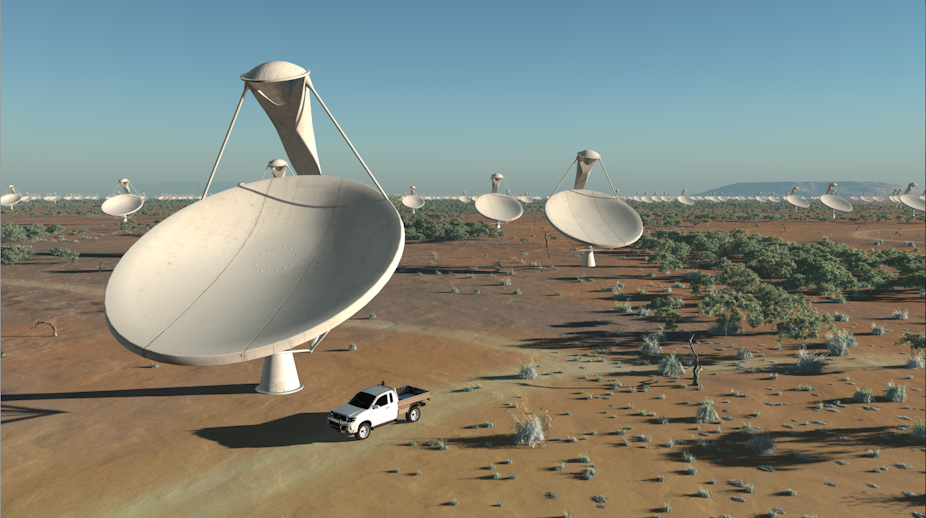The battle for the Square Kilometre Array (SKA) radio telescope is heating up. The SKA board was scheduled to choose a site – South Africa or Australia and New Zealand – earlier this year but a decision is not now expected until mid-May.
In early March reports emerged that the SKA Site Advisory Committee had recommended to the SKA board that South Africa represents the better host site. This recommendation has not been publicly acknowledged.
And, given there is “not an enormous preference for one over the other” (according to an SKA insider quoted by Nature) the selection committee has a difficult decision to make in the coming weeks.
So, what are the main selection criteria for the site of the SKA?
Radio quietness
Perhaps the most important factor is the “radio quietness” of the site. That is, the SKA site needs to be free from radio frequency interference (RFI).
RFI essentially refers to man-made radio signals – such as the signals created by radio and television stations – that can “outshine” (in the way the sun outshines other stars during the day) the signals astronomers are interested in detecting.
If there are too many RFI signals outshining the astronomical signals, the data will essentially be worthless.
Existing radio telescopes produce data at comparatively slow rates: at most, about a terrabyte for 24 hours of observation. As a result it’s not, usually, prohibitively expensive (in terms of time and effort) for researchers to scour the data for effects of radio interference and throw such data away.
The SKA will produce considerably more data than existing radio telescopes (see details below) and so the most cost-effective way to bring top-quality data to astronomers is to place the telescope in a region that does not have much radio noise.
Longevity
Radio telescopes, if built well, are built to last. The Parkes radio telescope, the subject of the Australian film The Dish, is still doing cutting-edge science 50 years after it was built.
Thus, given the cost to build the SKA – an estimated €1.5 billion – it should last as long, if not longer than Parkes has (so far) been around for.
The longevity of the SKA infrastructure is important but so is the longevity of the region’s radio quietness. The SKA site should be free of radio interference for most of this century, not just the next few years.
Stable weather
If you’ve ever listened to the radio on a long-distance drive, you might have noticed that the signal from FM radio stations don’t last as long as those on the AM dial.
This is because the lower-frequency AM signals (in the kilohertz range – thousands of wave cycles per seconds) can “bounce” off the earth’s ionosphere, a section of the planet’s upper atmosphere between roughly 85km and 600km in altitude.
This is something the higher-frequency FM radio signals (in the megahertz range - millions of wave cycles per second) don’t do.
You might have also heard the effects of radio signals during a thunderstorm – patches of static, known as “sprites” that can be heard with a regular radio receiver.
The astronomy that will be done by the SKA will be at frequencies similar (between 70 MHz and 10 GHz) to those used by FM radio stations. As a result, it’s important that the SKA site isn’t prone to bad weather, including storms.
This is why tropical regions weren’t considered as host sites for the SKA.
(Four sites were initially proposed: Australia, South Africa, Argentina and China. Bids from China and Argentina were discounted after significant evaluation surveys.)
Proximity
According to the SKA website, the finished telescope will produce data equivalent to between ten and 100 times the traffic of the entire internet … every day. That’s roughly 11,000 gigabytes (GB), or ten terrabytes (TB) of data every second!
(One TB is 1 trillion bytes – enough memory to store approximately 250,000 songs.)
Needless to say this amount of data takes a long time to move around.
While the above considerations require the SKA site to be distant from any radio noise, any prospective site also needs to be connected to high-quality optical fibre networks to get the data to where it can be analysed.
And, to minimise maintenance costs the SKA can’t be too far from a major population centre (Cape Town in the case of the South Africa bid; Perth in the case of the Australia/New Zealand bid.)
As said at the start of this article, it’s expected the SKA board will make a decision about the site mid-May with a public announcement to follow shortly after. Given the complex factors at play, I certainly don’t envy their task.

